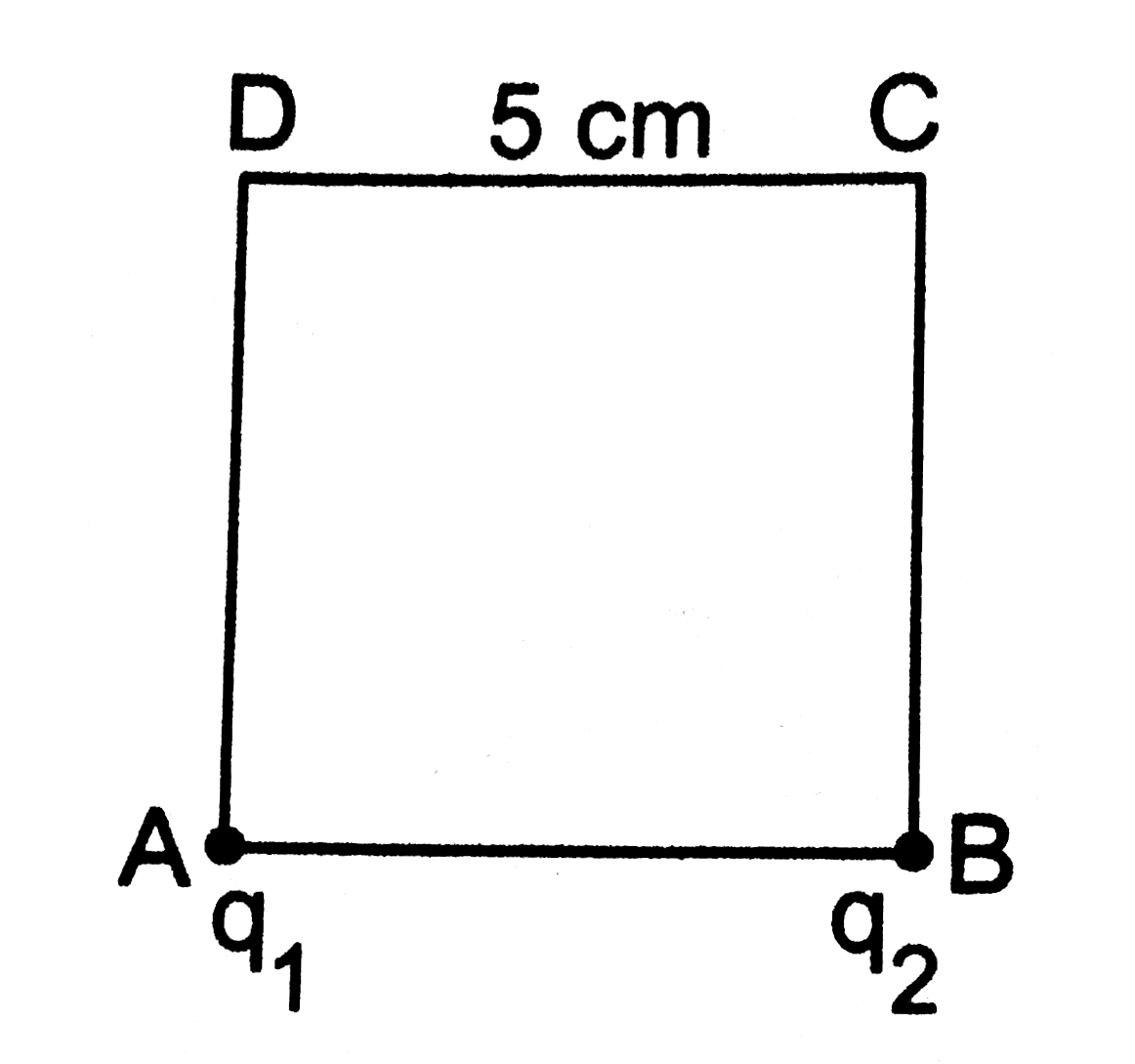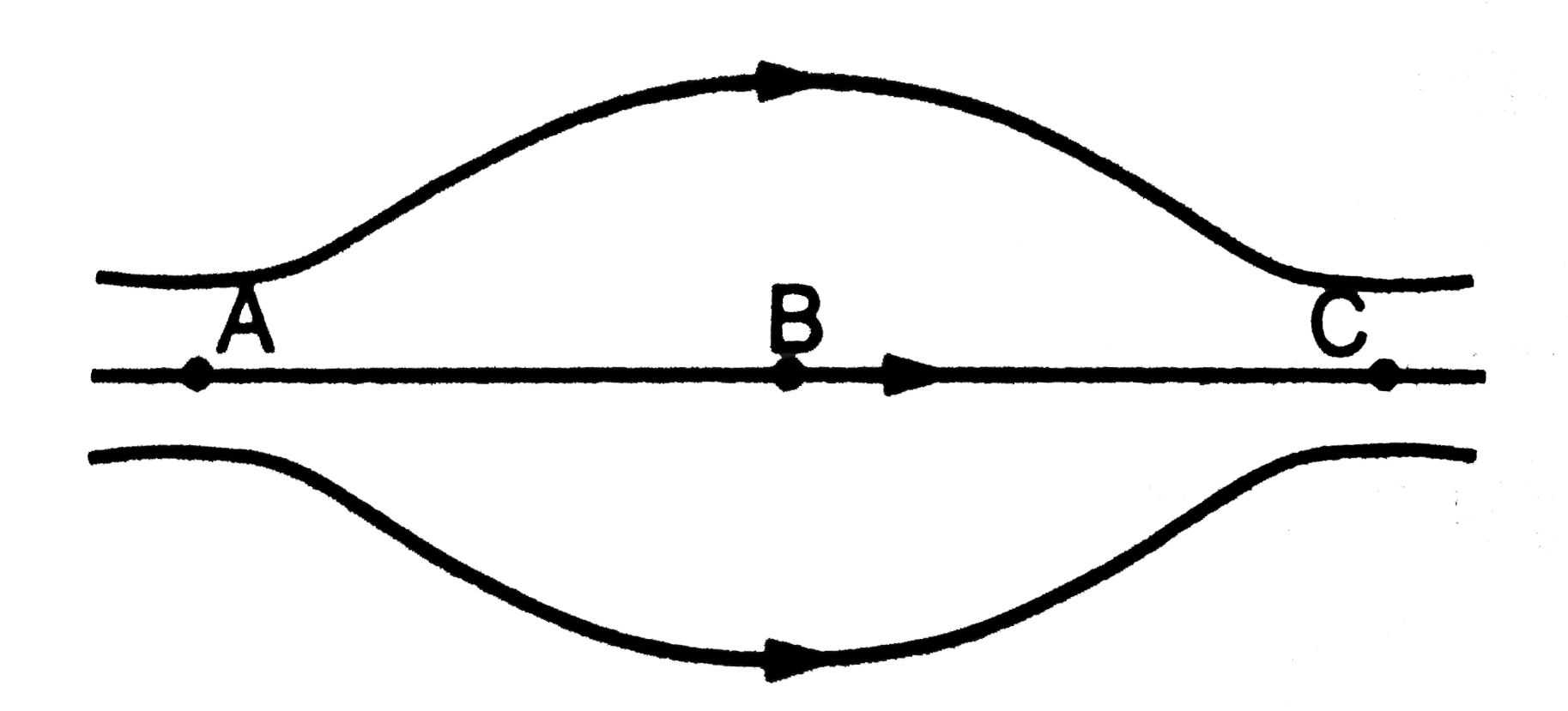charges 2.0×10−6C and 1.0×10−6C are placed at. corners A and B of a square of side 5.0cm as shown in. figure .how much work will be done against. the electric field in moving a charge of 1.0×10−6C from. C to D?.
 Solution in Tamil
Solution in Tamil
The electric potential at C
=14πε0(q1AC+q2BC)
=9×109Nm−2C(−2)⎛⎜⎝2.0×10(−6)C√2×0.05m+1.0×10(−6)C0.05m
=(9000V)(2+√2√2×0.05)
. The electric potential at D
=14πε0(q1AD+q2BD
=9×109Nm−2C(−2)(2.0×10(−6)C0.05m+1.0×10(−6)C√2×0.05m)
=(9000V)(2√2+1√2×0.05)<br>.Theworkdo≠aga∈stthee≤ctricfield∈mov∈gthe<br>char≥1.0xx 10(-6)CimC→disq(V_D- V_C)<br>= (1.0xx 10(-6) C)(900V) ((2sqrt2+1-2-sqrt2)/(sqrt2 xx o.05))
=0.053J
Topper's Solved these Questions
- BOOK - HC VERMACHAPTER - ELECTRIC FIELD AND POTENTIALEXERCISE - question for short answer14videos
ELECTRIC FIELD AND POTENTIAL
- BOOK - HC VERMACHAPTER - ELECTRIC FIELD AND POTENTIALEXERCISE - Objective 19videos
ELECTRIC FIELD AND POTENTIAL
- BOOK - HC VERMACHAPTER - ELECTRIC FIELD AND POTENTIALEXERCISE - Exercises75videos
ELECTRIC FIELD AND POTENTIAL
- BOOK - HC VERMACHAPTER - ELECTRIC CURRENT THROUGH GASESEXERCISE - Exercise23videos
ELECTRIC CURRENT THROUGH GASES
- BOOK - HC VERMACHAPTER - ELECTROMAGNETIC INDUCTIONEXERCISE - EXERCISE98videos
ELECTROMAGNETIC INDUCTION
Similar Questions
The charge on a proton is +1.6X10(−19)C and that on an
. electron is −1.6X10(−19)C. Does it mean that the electron
. has a charge 3.2X10(−19)c less than the charge of a
. proton?05:43View SolutionFigure shows some of the electric field lines correspoinding to an electric field. The figure suggests that
 02:34View Solution
02:34View SolutionFind the dimensional formula of ε0 .
02:20View SolutionA discharge tube contains helium at a low pressure. A large potential difference is applied across the tube. Consider a helium atom that has just been ionized due to the detachment of an atomic electron. Find the ratio of the distance travelled by the free electron to that by the positive ion in a short time dt after the ionization.
02:15View SolutionCalculate the dimensions of (a) ∫→E.d→l,(b)vBlanddΦ0dt. The symbols have their usual meanings.
04:48View SolutionSuppose the second charge in the previous problem is −1.0×10−6C. Locate the position where a third charge will not experience a net force.
06:59View SolutionThree charges q_1 = 1 xx 10^(-6) C, q^2 = 2 xx 10^(-6)C, and q_3 = -3 xx 10^(-6) C have been placed as shown in figure. Then the net electric flux will be maximum for the surface
05:39View Solutionएक विद्युत द्विध्रुव में +1.0×10−6C तथा −1×10−6C के दो बिन्दु आवेश एक-दूसरे से 2 cm की दूरी पर स्थित है। यह विद्युत द्विधुव 1.0×105 V/m के समरूप विद्युत क्षेत्र में स्थित है। ज्ञात करो-
द्विध्रुव पर विद्युत क्षेत्र द्वारा लगने वाला अधिकतम बलाघूर्ण |View Solutionएक विद्युत द्विध्रुव में +1.0×10−6C तथा −1×10−6C के दो बिन्दु आवेश एक-दूसरे से 2 cm की दूरी पर स्थित है। यह विद्युत द्विधुव 1.0×105 V/m के समरूप विद्युत क्षेत्र में स्थित है। ज्ञात करो-
द्विध्रुव पर स्थायी सन्तुलन की स्थिति में स्थितिज ऊर्जा |View Solution2 mu How much work will be required to move the point charge of C from corner A to corner B of a square ABCD (Fig. 3.42) if 10 mu Where is the charge of C located at the center of the square?
View SolutionCharges 5.0×10−7C,−2.5×10−7Cand1.0×10−7C are
held fixed at the three corners A, B, C of equilateral triangle of side 10cm respectively. Find the electric force on the charge at C due to the rest two.03:28View SolutionSuppose the second charge in the previous problem is −1.0×10−6C. Locate the position where a third charge will not experience a net force.
09:47View SolutionFour point charge of +10^(-7)C, -10^(-7)C, -2 xx 10^(-7)C and +2 xx 10^(-7)C are placed respectively at the corners A, B, C, D of a 0.05m square. Find the magnitude of the resultant force on the charge at D.
10:50View SolutionAn electric dipole consisting of two opposite charges 2×10−6C each separated by a distance of 3cm is placed in an electric field of 2×105N/C. The maximum torque on the dipole will be
02:49View SolutionAt the corners A,B,C of a square ABCD, charges 10 mC, -20mC are placed. The electric intensity at the centre of the square to become zero, the charge to be placed at the corner D is
02:38View SolutionTwo point charges 3×10–6C and 8×10–6C repel each other by a force of 6×10–3 N. If each of them is given an additional charge – 6×106 C, the force between them will be
View Solution

